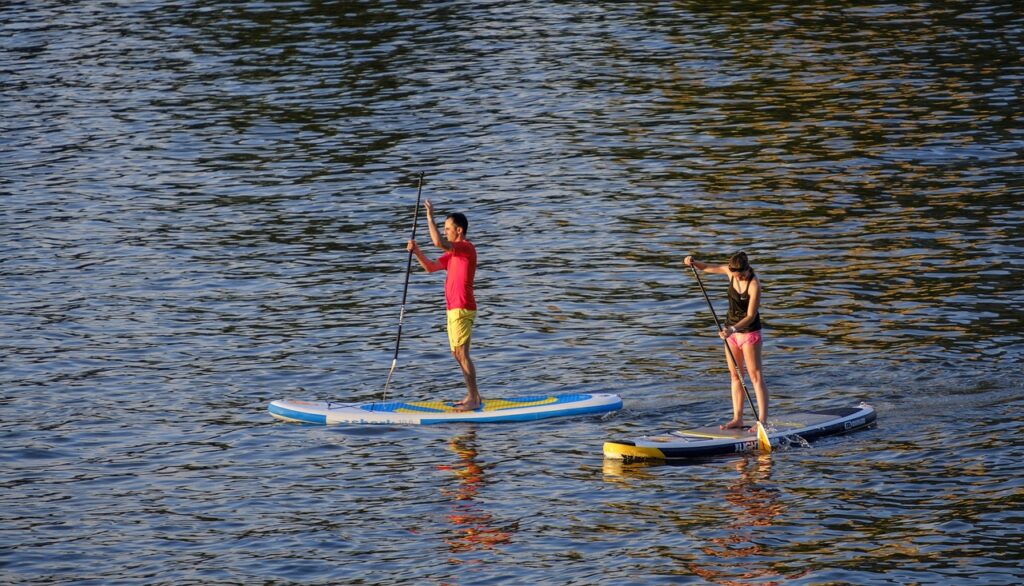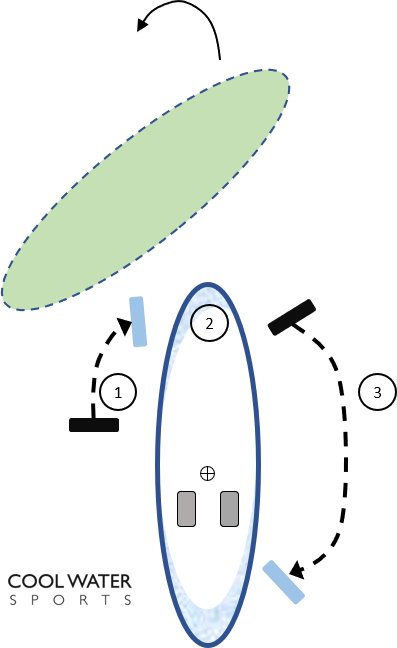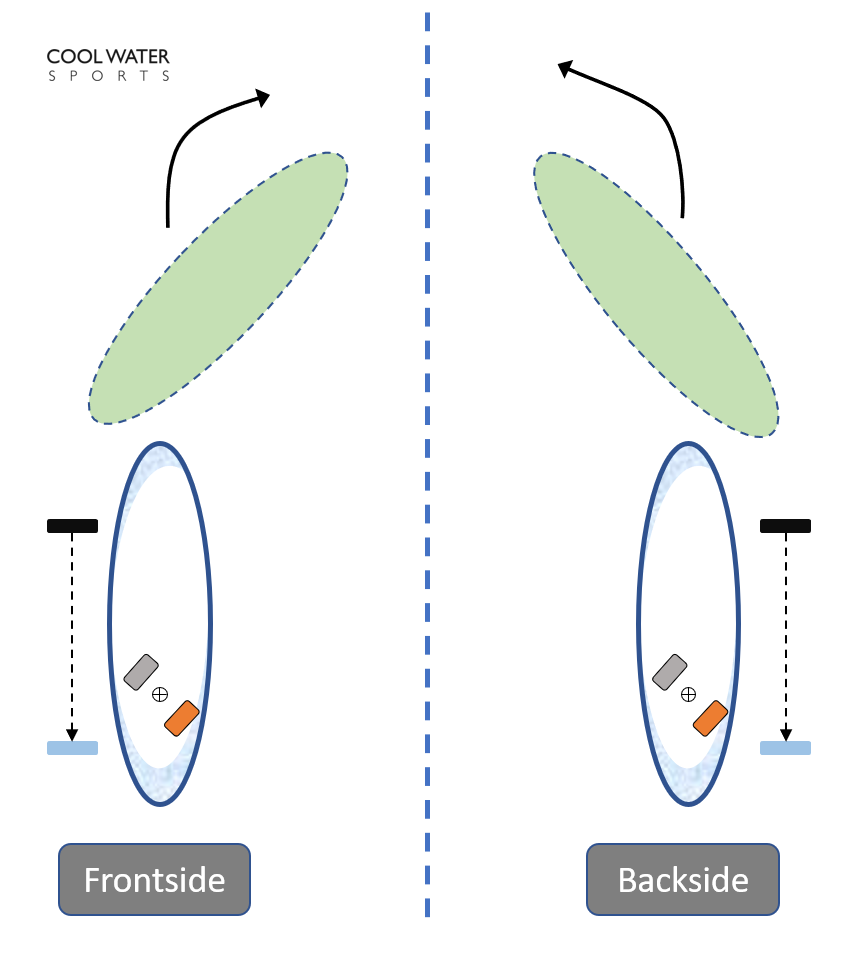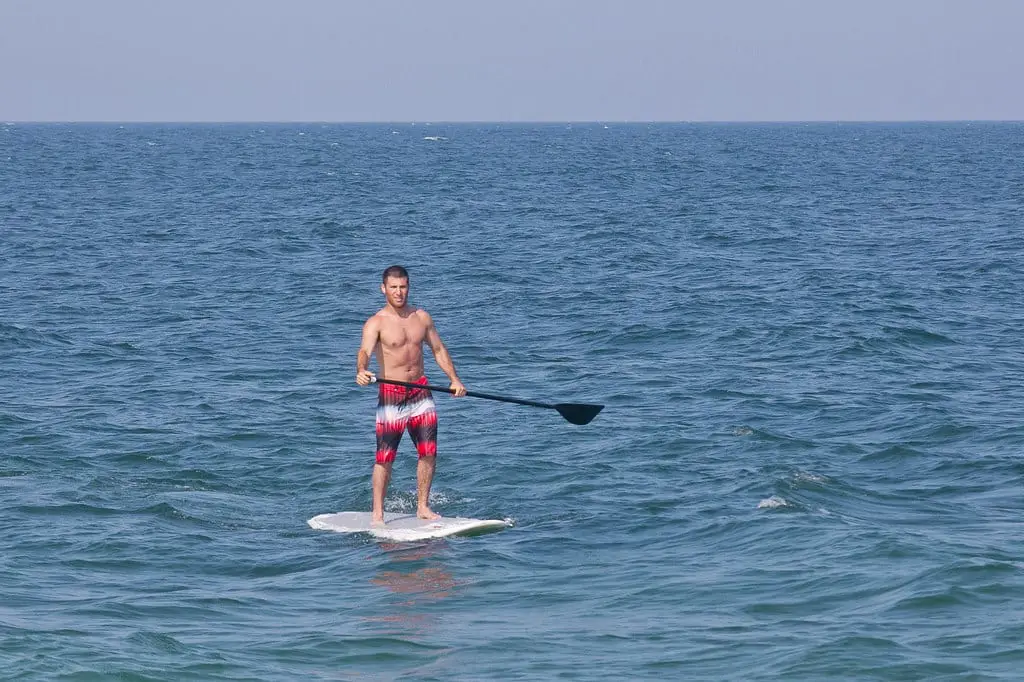Stand Up Paddling Tips – the sixth part of our “How to Stand Up Paddle Board”.
Learn the most important things about the Stand Up Paddle Board Turning Techniques – or how SUP Turns get easy.
In this article, we will show you everything about changing courses and turning:
- What is the easiest way to turn in SUP?
- What types of turns are there in Stand Up Paddling?
- What are the most stylish and efficient turns?
So that you can turn quickly and easily, your standing position on the SUP board is crucial. If you want to know more about the different SUP Standing Positions, check out the following articles about the different standing position on a SUP and how to paddle correctly. So take 5 minutes…

Our SUP graphics – so that the Technique becomes easier to understand
In order to explain the different techniques a little better, we will also use the following graphics in this section of the technique guide. These should help you to better understand the descriptions in the instructions.

Important Remarks:
In our stand up paddle instructions, we assume that you own or rent the required material. If not, check out our overview of boards and the Buying Guide!
As always, the “Safety Disclaimer” applies: stand up paddling is a water sport! You should therefore always adhere to the most important safety rules. If you know them yet, check them out quickly here.
What types of Stand Up Paddle board turning techniques are there?
We have already shown you some of the ways you can turn with Stand Up Paddling in the fifth part of our SUP Paddling Technique Guide:
- the sweep stroke
- the reverse stroke
Here we show you additionally:
- Cross sweep – Turn or Crossbow – Turn: The easiest way to turn the SUP board quickly
- Pivot turn: The cool and smooth way to turn around
So let’s dive right into the explanations.
The easiest ways to turn a SUP board
Turning with the sweep and reverse strokes: which option helps you in which situation!
In our fifth episode of the SUP Paddle Technique Guide, we presented the different types of paddle strokes. Of course, you can use these not only to control the SUP board, but also to turn it around.
The procedure is simple:
Repeat only one sweep stroke a few times on the same side of the board and you will stroke in a corresponding “bow” (that’s why it is also called a sweep stroke…).
Of course, you can also turn your board very quickly by making a reverse sweep stroke. The board will turn very quickly with the sweep on the side on which you perform the reverse stroke when stopping (paddle movement against the direction of travel). Of course, you also brake quite a bit and a large part of the speed is lost.
So you should only use this turn if the space is very tight or you really have to turn extremely quickly and precisely.
If you no longer know exactly what the different steering strokes are or how they work exactly, you are welcome to read it again here.
In addition to the option of simply repeating a sweep stroke, there are also other ways to do a turn.
The cross sweep – or crossbow – turn: The variation of the sweep stroke that turns the board faster
The cross sweep turn is nothing more than a “double” sweep stroke. It can be divided into three phases:
- Phase 1: Sweep stroke on the side to which the board is to be turned
- Phase 2: Lift paddle over the SUP board
- Phase 3: Sweep stroke on the other side
Important: you should not change your paddle posture throughout the entire cross sweep turn.

This means that it is not necessary to change your grip on the paddle during this turn.
With a fast cross sweep turn, it is possible to rotate the board by about 270° in one movement. This means that you can often move your board to the new position in one movement.
The disadvantage is certainly that this turn, especially if you have already picked up speed, needs a little more upper body strength and also slows you down relatively substantially.
Bonus SUP tip:
As with all turns and maneuvers, you should make sure that your knees and hips are relaxed.
This will help you have better stability on your Stand Up Paddle Board. This also allows you to continue the sweep, which of course makes you turn faster due to the greater leverage. If you are now wondering whether if it can be a bit “smoother” or more “stylish,” then of course: The solution is the so-called pivot turn.
The Pivot Turn: Cool, Effective and Fast
The most elegant, but also the fastest, way to turn the SUP board is the so-called pivot turn (or step back or kick turn). This certainly needs more practice than turning with a sweep stroke or the cross sweep turn: but we can only say that learning it is certainly worthwhile.
The pivot turn uses the properties of the Stand Up Paddle Board that it rotates via the center of gravity (i.e. the center of gravity of the board and the paddler).
This means that by moving your standing position on the board, you can influence the radius of the turn easily.
Basically, you can perform the pivot turn on both sides. This is also the aspect with which one distinguishes the two types of pivot turns from each other:
- Back Turn: The back (i.e. the back side of the body) points to the center of the radius of the turn
- Front Turn: the chest (i.e. the front side of the body) points to the center of the radius of the turn
The standing position is the same for both types. For this turn you change to the surf stand. To do this, you turn the foot, which is your front foot in the surf stance, briefly (together with a small step backwards) and then take a larger step towards the back of the SUP board with the other leg.

In order for the step change to work well, make sure that you always move over the middle of the board.
Bonus SUP tip:
if you make this step a paddle stroke at the same time, the paddle will help you to keep your balance (paddle support).
In the surf stance you can now shift your weight to the back leg. As a result, the stern of the board is pushed slightly into the water (i.e. the bow lifts out of the water) and thus the center of gravity or the pivot point moves backwards.
Result: with the shift of your weight you can influence the rotation radius of your turn.
Another way to change the rotation radius of the board is, of course, the length of the paddle stroke:
The faster you want to turn the board, the longer it will be. This also means that if you really want to make a short and crisp turn, you can pull the paddle stroke well over the stern of the board.
The difference between front and back turns is simple:
With the front turn you now paddle on the side of the SUP board where your heels are. Consequently, the board rotates away from the paddle side.

In the back turn you paddle accordingly on the side of your toes and the board will make a curve towards the back side.
Bonus SUP Tip:
Even in the surf stance, try to go slightly to your knees and keep your upper body upright. This helps enormously with stability of board and stance.
The completion of the pivot turn is no magic as well:
When your board has reached the desired end position, you take the step from the surf stance to the parallel stance at the same time as a paddle stroke.
The really cool thing about the pivot turns is that, with a little practice and experience, you can easily ride the turn razor-sharp and accurately both in the paddle stroke (changing the sweep shape, distance to the board, etc.) and in the standing position (farther forward, farther back, etc.).
Bonus SUP Tip:
To learn the pivot or step back turns, start with simple exercises where you move back and forth on the board.
Conclusion and summary
For the training on the water, take the following important information from the graphic with you on the way:
The most important techniques for SUP turns (Turning)
Reverse stroke, sweep stroke, cross sweep turn and pivot turns
Reverse stroke and sweep stroke: the simplest techniques
The easiest ways to turn are the reverse stroke and the sweep stroke.
Simply put, you turn the sweep stroke by not changing your paddle posture for more strokes than usual.
You can influence the radius of the turn with the width of your sweep stroke.
Cross sweep turn: turning faster than with the sweep stroke
If you want to turn faster and are willing to sacrifice some speed, then you can use the cross sweep turn.
In a parallel stance, execute a sweep stroke which goes over both sides of the board. This means that your paddle stroke begins on the side of the board in the direction of travel and ends on the corresponding other side.
Your paddle movement itself should be performed the same as a normal sweep stroke.
Pivot- or step back turn: the smoothest and fastest way to turn
The most elegant and versatile way to turn your board is the pivot turn.
A distinction is made between front turn and back turn. You perform the pivot turn standing in the surf stance.
This means you switch to the surf stance and shift your weight backwards beforming performing the turn.
As a result, your board will turn much more quickly and aggressively when you perform a normal sweep stroke.
And now, as always, we wish you a lot of fun while practicing!
Off into the water!
HOW TO STAND UP PADDLE BOARD: WHERE YOU CAN FIND MORE ABOUT PADDLE BOARD TECHNIQUE
We hope that this overview of some of the basics of SUP Paddle Technique will help you with your first excursions on the water.
And remember: Practice is key and even fun with SUP!
So off to the water and get wet! If you still want to know more on How to Paddle Board and SUP paddle techniques, take a deeper look at the other tips in our SUP Tips & Advice section.






